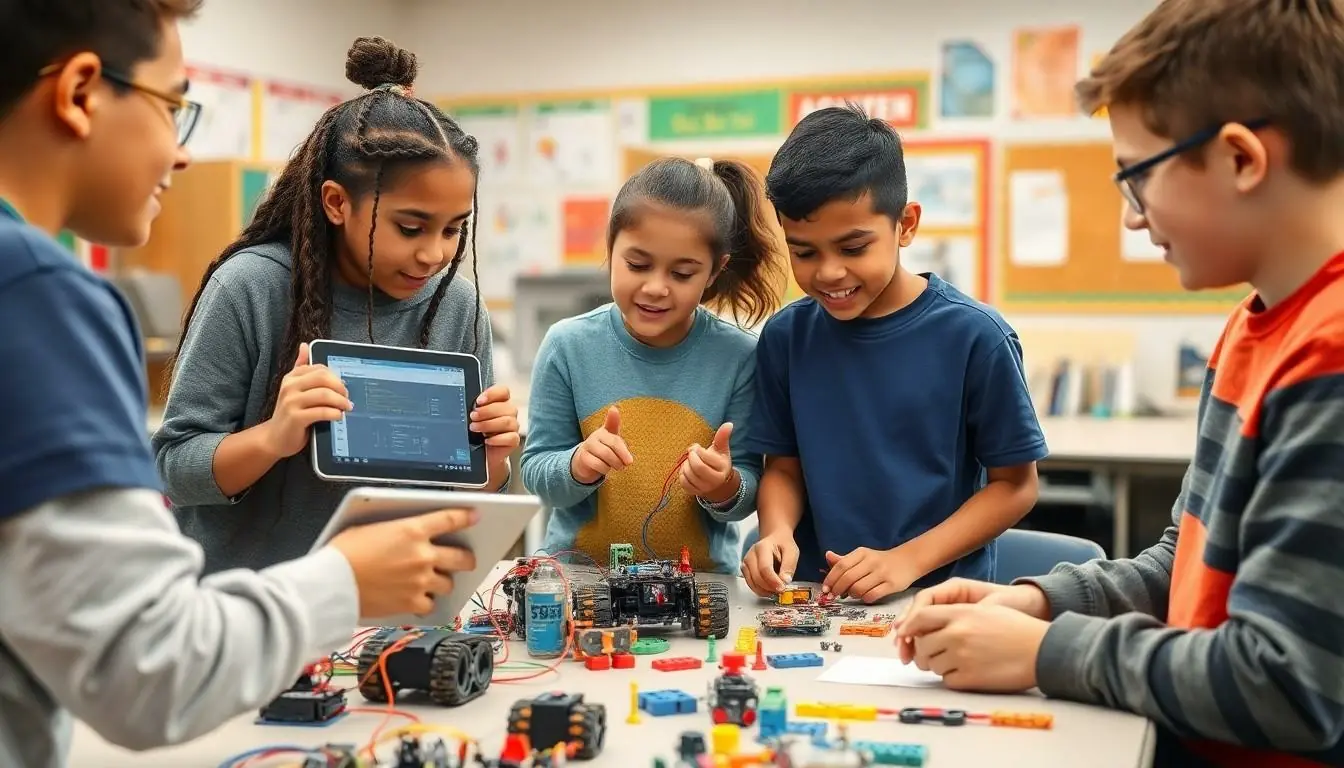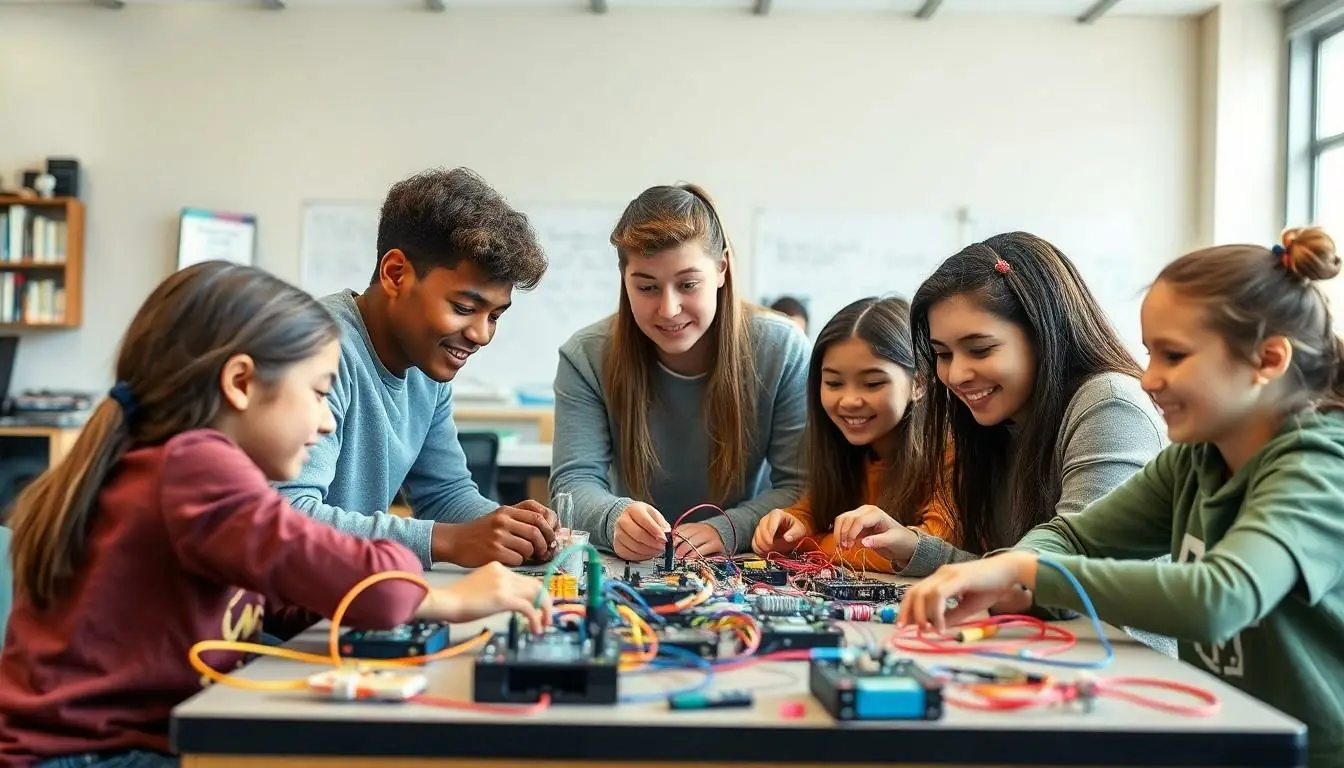Table of Contents
ToggleMiddle school is a wild ride, filled with awkward moments and the quest for the perfect lunch table. But amidst the chaos, there’s a golden opportunity to ignite a passion for STEM. Imagine students solving real-world problems while having a blast—sounds like a superhero movie, right? Well, it’s not far off!
Overview of STEM Challenges in Middle School
Middle school students face several challenges related to STEM content. Engaging this age group often requires innovative methods. Many students exhibit a lack of interest in traditional STEM subjects, which presents a barrier to learning.
Hands-on activities and collaborative projects can spark curiosity. Adopting a problem-based learning approach encourages students to tackle real-world issues. This method helps reinforce critical thinking skills while addressing the curriculum.
Another challenge involves varying levels of preparedness. Students come from different backgrounds, leading to diverse skill sets in mathematics and science. Teachers must navigate these differences to provide equitable learning opportunities.
Limited resources also impact STEM education quality. Schools may not possess adequate materials for experiments or technology for coding projects. This shortfall can hinder effective instruction and student engagement.
Facilitating partnerships between schools and local businesses can provide additional resources. Programs that connect students with professionals offer insights into STEM careers. Such exposure motivates students and highlights the relevance of their studies.
Additionally, promoting a growth mindset in students proves essential. Encouraging perseverance when facing challenging problems builds resilience. This perspective emphasizes that effort leads to improvement, a key factor in STEM learning.
Schools can further enhance engagement by incorporating competitions. Contests, such as science fairs or robotics challenges, foster collaboration and excitement. These events showcase student innovation while building community support for STEM initiatives.
Importance of STEM Education
STEM education plays a crucial role in shaping middle school students’ academic and personal growth. Engaging students in STEM can ignite passion for subjects crucial to future careers.
Benefits for Students
STEM education enhances students’ problem-solving abilities. They develop collaboration skills by working in teams on projects. Interest in technology grows as students interact with various tools and resources. Encouraging creativity allows them to explore innovative solutions to real-world challenges. Participation in STEM activities promotes a sense of belonging and community among peers.
Skills Developed Through STEM
Critical thinking skills flourish in a STEM learning environment. Students learn to analyze information and make informed decisions. They gain technical skills through hands-on approaches to learning. Communication skills improve as students present their projects and ideas. Adaptability emerges as they navigate challenges and learn from failures, paving the way for future success.
Common STEM Challenges Faced by Middle Schoolers
Middle schoolers encounter various STEM challenges that can impact their educational journey. Understanding these issues can help educators tailor their approaches.
Lack of Resources
Limited resources significantly affect the quality of STEM education. Schools often struggle with insufficient lab equipment, outdated technology, or a lack of materials for hands-on projects. Teachers face difficulty engaging students when they can’t access essential tools for practical learning. Innovative solutions may arise from partnerships with local businesses or community organizations willing to contribute funds or materials. Such collaborations can bridge gaps, offering students richer learning experiences that spark interest in STEM subjects.
Engagement and Interest
Many students express low engagement and interest in STEM fields. Traditional teaching methods often fail to resonate with middle schoolers, leading to apathy towards subjects like science and mathematics. Interactive learning experiences, such as coding workshops or robotics clubs, can capture students’ attention effectively. Projects that encourage collaboration and competition contribute significantly to enhancing overall interest in STEM. By fostering a sense of camaraderie, these activities help students appreciate the relevance of STEM in real-world scenarios.
Curriculum Limitations
Curriculum limitations pose challenges to effective STEM education in middle schools. Standards often emphasize rote learning, which fails to nurture critical thinking and problem-solving skills. A rigid curriculum can restrict the exploration of emerging STEM fields, leaving students unprepared for future careers. Adopting a flexible, project-based curriculum enables educators to tailor lessons to student interests and current technologies. Real-world applications integrated into lessons promote not only comprehension but also enthusiasm for STEM subjects, paving the way for a more engaged learning experience.
Strategies to Overcome STEM Challenges
Engaging middle school students in STEM involves proactive strategies that address existing challenges effectively.
Hands-On Learning Approaches
Interactive, hands-on learning environments play a vital role in STEM education. By incorporating experiments and building projects, students actively participate in the learning process. Activities like science fairs and coding camps spark curiosity and encourage exploration. Students gain firsthand experience while applying theoretical concepts in practical situations. Providing access to modern tools, such as 3D printers and programming software, enhances their skills further. Teachers implementing these projects can stimulate critical thinking and collaborative problem-solving among peers.
Collaboration with Local Organizations
Involving local organizations in STEM initiatives fosters valuable partnerships. Businesses can supply resources, mentorship, and material support to schools. Collaborations with institutions like museums and universities can bring real-world expertise into the classroom. Students benefit from field trips and guest lectures presented by industry professionals. Engaging community resources helps create a network that reinforces classroom learning. Schools with these partnerships often see increased enthusiasm for STEM subjects and improved student outcomes.
Conclusion
Middle school presents a crucial opportunity to ignite students’ interest in STEM fields. By addressing the challenges of limited resources and traditional teaching methods, educators can create engaging environments that foster curiosity and collaboration. Implementing hands-on activities and forming partnerships with local businesses can significantly enhance the learning experience.
As students navigate these challenges, they not only develop essential skills but also cultivate a sense of community and belonging. Emphasizing project-based learning and real-world applications will prepare them for future success in STEM careers. By investing in innovative educational strategies, schools can inspire the next generation of problem solvers and innovators.







